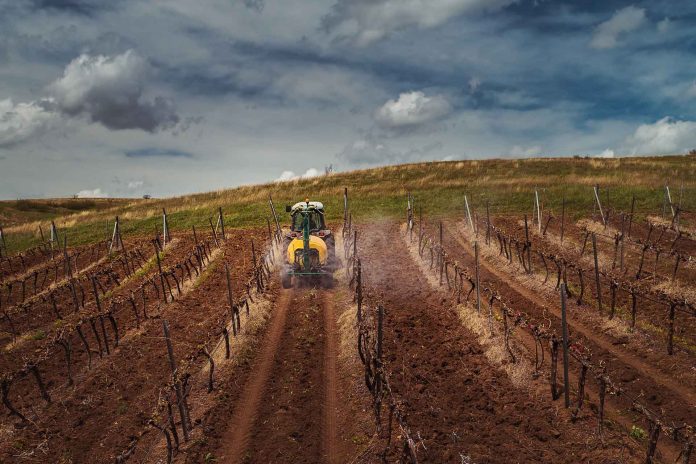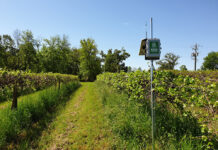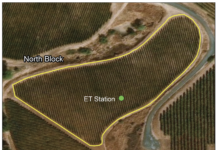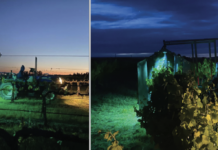From wine grapes to table grapes and raisins, there are several ways to prevent and manage weeds in the vineyard. Ideally, weeds are managed while they’re still small, since the crop is closer to the ground, and taller weeds can provide easy access for pests, disease, and other complications.
While industry best practices and research hasn’t changed significantly very recently, there has been one change that farm advisors now recommend to growers: spray volumes.
“The old recommendations were thirty gallons an acre,” says Kurt Hembree, Weed Management farm advisor for the University of California Cooperative Extension, “but it really needs to be about forty to fifty gallons an acre.”
Farm advisors are seeing better results for the contact herbicides at this higher volume, with better coverage and less weed regrowth, and overall a cleaner vineyard floor than at the lower volumes. Everything else, including timing and materials, remain the same.
The main component of struggling with weed control is the fact that even though herbicide labels are very specific about application timing, many growers get into the field later than they should. Sometimes pruning can take growers into the middle of winter, and by then there are rainstorms that can prevent them from getting out into the field, especially in vineyards with heavier soils.
Before growers catch themselves at odds in the winter, there are things that can be done earlier to ensure a well-implemented program. “Late summer and early fall is a great time to make sure all your equipment is working properly,” says Hembree. “Check your spray nozzles and all your machinery.”
Whichever weed management program a grower chooses, Hembree insists on sticking to it, and adhering as closely as possible to the timings. “As soon as everything is pruned and the canes come out of the field, be ready to go. Timing is the biggest issue. Like in the case of raisins, you only have a few months before the canopies touch the ground.”
Another major key for ensuring spray effectiveness is cleaning up trashy berms and keeping them clean. If there is debris at the base of your vines, there’s no telling whether or not the spray chemicals are making it into the soil and reaching the weeds, or if they’re getting stuck and then washing away.
According to Hembree, if the field is clean and the proper spray timings are followed, the rest of any weed management program will fall into place.
This is especially true for organic vineyards, as trying to rein in weeds from an organic standpoint is very challenging. This becomes trickier because available options are much more limited, but organic growers who dedicate the right equipment, manpower, and timing can do just as well.
Doing nothing—in both organic and conventional—is a recipe for disaster, and can wreak havoc on the crop, the harvest crew, and the bottom line. Using raisin grapes again as an example, tall horseweeds or prickly lettuce can overrun a vineyard, which can also bring white flies and leaf hoppers. Combine this with an angry crew that has to fight with weeds to hunt for clusters, a too-lax weed management system will have weeds seeds nestled in the folds of raisins and will, therefore, result in a contaminated crop.
“I’ve seen weeds seeds end up in the trays, and I’ve seen loads get rejected from overseas because of them,” says Hembree.
Growers who are vigilant about their weed management program will benefit greatly because of it. Both pre-plant and post-plant options are available to control weeds in vineyards.
Pre-Plant Options
Preparing the soil prior to planting a new vineyard is a great time to initiate a solid weed management regiment. For one, controlling weeds at this stage is critical because of the competition for resources that can happen if weeds are present during the planting of vines. An irrigation program that supports weed seed germination, which is then followed by tillage to uproot these new seedlings, can help greatly reduce the presence of weeds. There’s also the option of burying seeds even further beneath the ground, preventing them from sprouting at all. However, a drawback of this is that the soil shouldn’t be tilled for about four years, otherwise the seeds might be brought back to the surface and germinate.
There is also the option of laying UV-inhibiting, clear plastic between rows that are six feet wide and damp. The longer the days, the better, and this should be started no later than late August in most California regions to ensure that this process can be completed within four to six weeks, before the seasonal change.
Post-Plant Options
Most vineyards aren’t starting anew when it comes to weed management, so staving off weeds can either be a proactive endeavor, or a reactive one that can leave growers—and harvest crews—battling weeds.
Cultivation
With this method, weeds can either be uprooted or buried, with uprooting working better for larger weeds, and burial working better for smaller ones. Keeping the depth of grape roots in mind, cultivation ideally destroys weed roots to remove current plants without turning over the soil enough to allow for germination of new seeds. Established perennial weeds will need more attention in order to remove them, and growers may need a special mechanism to protect vine roots.
Flaming
When a burst of heat is applied at 130°F, the plant’s cell wall ruptures. This is most effective on non-grass plants that have fewer than two true leaves. Burning isn’t necessary, and a weed that loses its shine or retains a fingerprint when pressed has been adequately flamed. Propane-fueled flamers are the most commonly used models for weeds in the vine row, and it’s extremely important to avoid this method in windy conditions or around dry vegetation of any kind.
Herbicides
Contact herbicides are effective, and since the results are dependent upon the chemicals touching the plant, they can also damage grape leaves and vines. New flushes of weeds will require additional application, as contact herbicides don’t generally have a residual effect. Following all provided directions—from application method and timing, to protective equipment and storage—is extremely important when using any specific herbicides.
Mulch
What is weed control without the mention of mulch? While mulch can be made from a variety of materials, such as wood chips, straw and even newspaper, the ultimate goal is to completely block any light from reaching seeds, thus preventing germination. Organic mulches break down faster, so the layer will have to be thicker. Winter cover crops can be cut and then moved to be used as mulch. Though cover crops can outcompete weeds, they can also compete with the vine. Mulches in general may provide cover for some unwanted visitors as well, such as rodents that can damage vine trunks and roots.
Whichever method a grower chooses, it’s helpful to keep a weed survey of the field. These records can assist in method selection, can track changes in the field, and can help with diligently sticking to a weed management program, which is imperative for vineyard success.




















